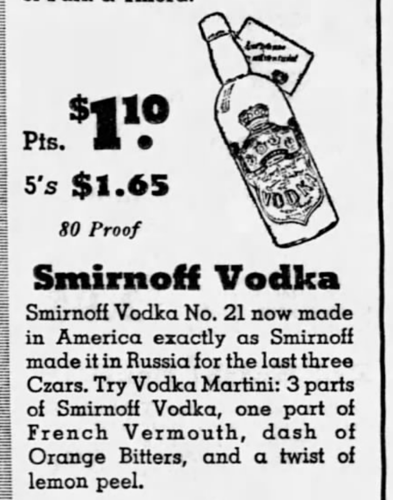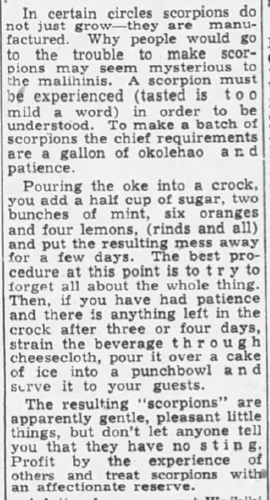Much as we have discussed essential figures and the canon, here’s a list-in-progress of the mixed drinks that either formed the basis for the American Bar, or are, for better or worse, its best-known accomplishments. Some of my dates are probably wrong, or are attempts to fudge a messy situation—I can easily be nudged in most any direction to refine and improve the list.
(all Imbibe page references below are to the Second Edition)
julep (as medicine, by 900, Persia, Imbibe p. 189)
punch (c 1670s, Imbibe p. 82)
hot spiced rum (17th C and earlier, Imbibe p. 204)
Stoughton’s Elixir [instant purl/proto Cocktail] (1690, Richard Staughton, London, Imbibe p. 210-11)
sangaree (c 1736-1740, London and Maryland, from Iberian sangria, Imbibe p. 201)
toddy (by 1750, Scotland, Imbibe p. 171)
Mint Julep (1770; Virginia Gazette, Jan. 11th, p. 2: “A Short Poem on Hunting.”)
Egg Nogg (by 1788, Imbibe p. 160)
sling (by 1785, Imbibe p. 184-5)
Cocktail (by 1803, but probably between ~1785 and 1800, Imbibe p. 215)
Sherry Cobbler (c. 1820s-1837, probably in New York, possibly by Martha King Niblo at Niblo’s Garden between. 1828 and 1838, Imbibe p. 141-2 and this article)
John/Tom Collins (late 1820s, John Collin, Limmer’s, London, and evolved its way to 1872 New York, this article)
smash (by mid-1830s, Imbibe p. 200)
Champagne Cocktail (prior to 1850 in California, everywhere thereafter; Imbibe p. 302)
Crusta (c. Joe Santini, 1850-1855, New Orleans, at City Exchange or Jewel of the South, Imbibe p. 314)
Caipirinha (by 1856, near Rio, this article)
Pisco Punch (c. 1856, Mrs. Sykes, San Francisco, Imbibe p. 89)
fix (c. 1850-1856, Imbibe p. 113)
sour (c. 1850-1856, Imbibe p. 113)
swizzle (1860s Caribbean, Imbibe p. 154-5)
Vermouth Cocktail (1868; NY Herald, June 14, “A Bohemian banquet to the Sorossians”)
Gin & Tonic (1868, Oriental Sporting Magazine, November 16, “1868-Seakote Races” p. 838)
fizz (c. 1870-1876, Imbibe p. 133)
Improved Cocktail (c. 1870-1876, Imbibe p. 235)
daisy (July 7, 1873, Frank Haas, Eberlin’s, New York, Imbibe p. 127-8)
Sherry Flip (by 1874, possibly Ed Simmons at French’s Hotel, New York, Imbibe p. 168)
Manhattan (by 1882, New York, Imbibe p. 252-6)
Martini (by various names, with Italian vermouth) (by 1884, Imbibe p. 260-2)
Rickey (c. 1883-1889, “Colonel” Joe Rickey, Shoomaker’s, Washington DC, Imbibe p. 147)
Bamboo (by 1886, Louis Eppinger, San Francisco, Imbibe p. 280-1)
“Old Fashioned” (c. 1888, Chicago, Imbibe p. 244-5)
Ramos Gin Fizz (c. 1890s, Henry Charles Ramos, Imperial Cabinet, New Orleans, Imbibe p. 138)
Sazerac (c. 1893, Billy Wilkinson and/or Vinent Miret, Sazerac House bar, New Orleans, Imbibe p. 237-8)
Cafe Brulot (c. 1895, Jules Alciatore, Antoine’s, New Orleans, [need better source])
Rob Roy (by 1897, New York/New Jersey, Imbibe p. 270-1)
Jack Rose (c. 1899, possibly Eberlin’s, Imbibe p. 321)
Planter’s Punch (c. 1900 Jamaica; OCS p. 547)
Cuba Libre (c. 1900, Cuba, commensurate with Coca-Cola being imported to Cuba)
Clover Club (c. 1900-1901, presumably from the Club at the Philadelphia Bellevue-Stratford Hotel, and then through the Waldorf-Astoria, Imbibe p. 322)
Dry Martini (between 1890-1896, Imbibe p. 265-6)
highball (1890s, Scotland, evolved from 1860s Cooler and Collins)
Singapore Sling (by 1897, Imbibe p. 152)
Daiquiri (c. 1897 Cuba, Robert Huntington Lyman Jr. and Jennings S. Cox, Jr., popularized c. 1909 at Navy Club, Washington, Imbibe p. 324 and this article)
Americano (Highball) (c. late 1890s, Italy; family of drinks combining vermouth, soda and Italian bitters; perhaps first appears by name in a German cocktail book and made with Fernet; in any case, not made with Campari until after 1904, except perhaps in Gaspare Campari’s own Milanese shop; this article)
Pisco Sour (c. or by 1903, Imbibe, p. 120)
Ward 8 (c. 1905, Charlie Carter at the Puritan Club, Boston, Imbibe p. 329)
Stinger (c. 1900-1909, Reginald Vanderbilt, New York, Imbibe p. 332)
Bronx (1900-1907 New York, possibly the Waldorf, Imbibe p. 319)
Gibson (by 1904, San Francisco, Imbibe p. 266-7)
Ohio (c. 1910, Germany; earliest known printed reference is Schoenfeld & Leybold, 1913)
El Presidente (c. 1910-1915, Contante Ribalaigua, Havana, Imbibe p. 289-91)
Rose (Giovanni “Johnny” Mitta, Chatham bar, Paris, ca. 1910; this article)
Aviation (c. 1916 Hugo Ensslin in his Recipes for Mixed Drinks)
Negroni (c. 1912-1920, Camillo Negroni and Fosco Scarselli, Casoni’s, Florence, but not popularized until late 1920s, this article)
Sidecar (c. 1922, attribution unclear, but first documented in Robert Vermeire’s Cocktails How to Mix Them, London)
White Lady (c. 1922, attribution unclear, but first documented in Harry McElhone’s Harry’s ABC of Mixing Cocktails, London)
Brandy Alexander (c. 1922, first documented in Harry McElhone’s Harry’s ABC of Mixing Cocktails, London)
Mojito (c. 1920s, Cuba, first documented in Juan Lasa’s Libro de Cocktail, 1929)
French 75 (c. 1927, Judge Jr.’s “Here’s How”, New York)
Margarita (c. 1929, Agua Caliente, Mexico, Imbibe p. 129)
Bloody Mary (c. 1930s, evolved from canned tomato juice drinking, the Prohibition-era Tomato Juice Cocktail, the inevitable spiking of said beverages, and ultimately, a couple waves of Russian and Polish immigration and the popularization of vodka, known by various names on both sides of the Atlantic, this article)
Zombie (c. 1934, Ernest Raymond Beaumont Gantt, Don’s Beachcomber, Hollywood)
Vodka Martini (first known reference is a 1935 Smirnoff pamphlet—a marketing inevitability—and possibly spurred on by recent waves of Russian and Polish immigration)
Scorpion (1930s, Honolulu; first known reference is 1937, see below; lightly adapted in the 1950s by Trader Vic as the popular Scorpion Bowl)
Moscow Mule (1942, pushed by marketing efforts of Heubliein/Smirnoff)
Mai Tai (1944, Victor Bergeron, Trader Vic’s, Oakland)
Irish Coffee (1945, served in Ireland as “Gaelic Coffee”; Washington, DC Sunday Star, Deecember 9, “Overnight by Air to a Weary England”; popularized in US at Buena Vista Cafe, San Francisco, beginning in 1952)
Grasshopper (late 1940s, early 1950s, “the Midwest”; OCS p. 333)
Aperol Spritz (1950s, Venice, Aperol becomes regionally popular as a Spritz Veneziano flavoring; Grupo Campari acquires Aperol in 2003 and markets the product with the drink, building an international phenomenon by 2011)
Piña Colada (c. 1954, commencing with the introduction of Coco López to the market)
Blue Hawaii (c. 1957, Harry Yee, Hawaiian Village Hotel, Honolulu)
Harvey Wallbanger (c. 1969, attribution murky, but it’s a modified Screwdriver pushed by McKesson Imports to sell Galliano)
Tequila Sunrise (c. 1972, Bobby Lozoff and Billy Rice, Trident, Sausalito)
Lemon Drop (1970s, Norman Jay Hobday, Henry Africa’s, San Francisco)
Long Island Iced Tea (c. 1972, Robert Butt, Oak Beach Inn, Long Island)
Cosmopolitan (1988, Toby Cecchini, Odeon, New York)
Appletini (c. 1996-7, Lola’s Restaurant, West Hollywood, after introduction of DeKuyper Sour Apple Pucker)
Please comment/augment/correct. (This is a wiki post.)


